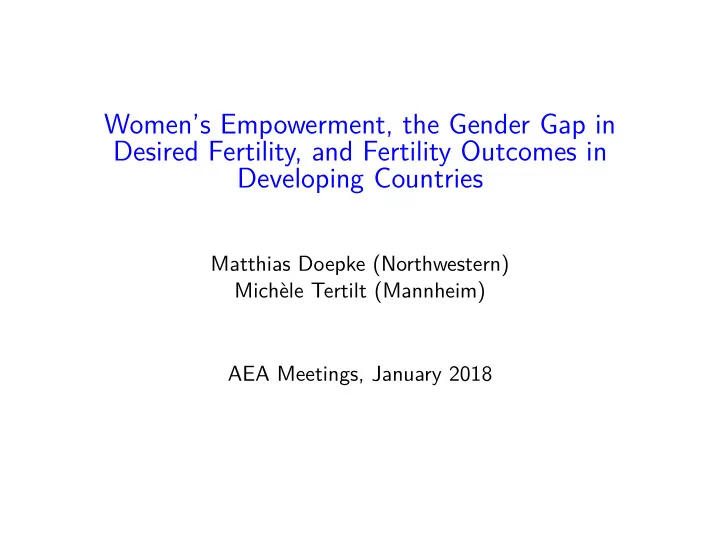

Women’s Empowerment, the Gender Gap in Desired Fertility, and Fertility Outcomes in Developing Countries Matthias Doepke (Northwestern) Michèle Tertilt (Mannheim) AEA Meetings, January 2018
Fertility and Development ◮ Fertility is important: ◮ Children are costly. ◮ Link to human capital accumulation.
Fertility and Development ◮ Fertility is important: ◮ Children are costly. ◮ Link to human capital accumulation. ◮ Fertility is special: ◮ It takes two to make a baby.
Fertility and Development ◮ Fertility is important: ◮ Children are costly. ◮ Link to human capital accumulation. ◮ Fertility is special: ◮ It takes two to make a baby. ◮ Does this matter? ◮ Document widespread disagreement over fertility between women and men in developing countries.
Fertility and Development ◮ Fertility is important: ◮ Children are costly. ◮ Link to human capital accumulation. ◮ Fertility is special: ◮ It takes two to make a baby. ◮ Does this matter? ◮ Document widespread disagreement over fertility between women and men in developing countries. ◮ A research agenda: ◮ Incorporate household bargaining into models of fertility. ◮ Model interaction between women’s rights and fertility.
Female Empowerment and Fertility .6 .4 SIGI .2 0 0 2 4 6 8 Fertility in 2010 OECD Social Institutions and Gender Index (SIGI) measures women’s rights on scale from 0 (full rights) to 1 (no rights).
Female Empowerment and Fertility ◮ Cross-country correlation TFR and SIGI: 0.66. ◮ After controlling for GDP per capita: One standard deviation increase in empowerment associated with decline in TFR of 0.57. ◮ Suggests women want fewer children, and more empowerment gives women more say. ◮ Consistent with Ashraf, Field, and Lee (2014): Giving women access to concealable birth control substantially lowers fertility.
Women’s and Men’s Desired Fertility across Countries 15 Chad Niger Men's Desired Fertility 10 Senegal Gambia 5 0 0 2 4 6 8 10 Women's Desired Fertility Demographic and Health Surveys, various years.
Gender Gaps in Desired or Realized Fertility? ◮ Countries with high population growth and large age gaps between spouses also have gender gaps in realized fertility. ◮ If there is polygyny and every man marries n women, have: f m = nf f . ◮ How this adds up: With age gap a and population growth η every man can marry n = (1 + η ) a women. ◮ Also possible without polygyny: either more women remain childless, or serial monogamy. ◮ Empirically, polygyny accounts for substantial part of gender gap in desired fertility.
Gaps in Desired Fertility at the Couple Level ◮ Demographic and Health Surveys. ◮ Illustrate with two countries: ◮ Burkina Faso (high polygyny), year 2010-2011. ◮ Ethiopia (low polygyny), year 2011-2012. ◮ Focus on women age 40+ (to measure completed fertility).
Distribution of Gap in Desired Fertility between Husband and Wife .08 .06 Density .04 .02 0 -10 -5 0 5 10 Difference in ideal number of children Burkina Faso Ethiopia
Desired Fertility Matters for Realized Fertility Regressions of realized on desired fertility (women 45+, desired children 15 or less): Burkina Faso Burkina Faso Ethiopia Ethiopia ¯ 0.38 ∗∗∗ 0.33 ∗∗∗ 0.16 ∗∗ 0.08 n f ¯ n m 0.19 ∗∗∗ 0.12 ∗ 0.20 ∗∗ 0.12 ∗ h f -4.30 ∗∗∗ -4.97 ∗∗∗ h f × ¯ 0.36 ∗ 0.34 ∗ n f h f × ¯ 0.24 0.15 n m R 2 0.21 0.25 0.09 0.23
Desired Fertility Matters for Realized Fertility ◮ However, role of empowerment not clear cut. ◮ Some variables that don’t have large effects: ◮ Education gap between spouses. ◮ Age gap between spouses. ◮ Female labor supply. ◮ Index of woman’s power in decision making.
Why Do Spouses Disagree on Optimal Number of Children? ◮ We don’t know much. ◮ In Burkina Faso, polygyny and education gap matter; not so in Ethiopia. ◮ In Ethiopia, women’s say in household decisions matters; not so in Burkina Faso. ◮ Generally, in regressions only small fraction of variation can be accounted for ( R 2 well under 10 percent).
From Desired to Actual Fertility in Models of Household Decision Making ◮ Role of female empowerment depends on mode of decision making in the household. ◮ Doepke and Tertilt (2009): polar cases of patriarchy (men decide) and equal power. Empowerment regime maximizes sum of utilities under commitment. ◮ Patriarchy: Actual fertility equal to man’s desired fertility. ◮ Empowerment: Actual fertility is weighted average of woman’s and man’s desired fertility.
From Desired to Actual Fertility in Models of Household Decision Making ◮ Very different outcome in bargaining model with limited commitment (Doepke and Kindermann 2009): ◮ Sequential fertility choice, each spouse has veto power over adding children. ◮ Actual fertility is minimum of woman’s and man’s desired fertility. ◮ Dispersion in desired fertility has first order effect on average fertility. ◮ Doepke and Kindermann argue that veto model matches rich-country data well. ◮ What happens at intermediate stages between patriarchy and full empowerment?
Conclusion & Research Agenda ◮ Theory suggests that women’s empowerment and household decision making should be hugely important for fertility in developing countries. ◮ Data supports this view. ◮ Need better models: Bargaining over fertility beyond polar cases of patriarchy and full empowerment. ◮ Need better data: Desire to have an additional child right now linked to fertility outcomes.
Recommend
More recommend